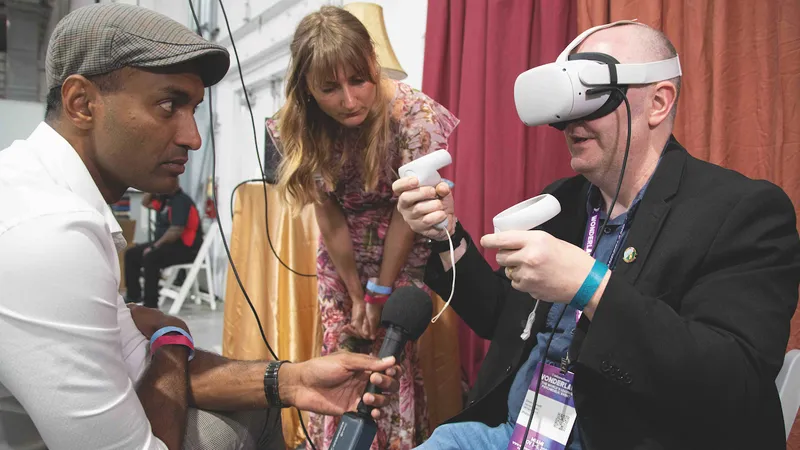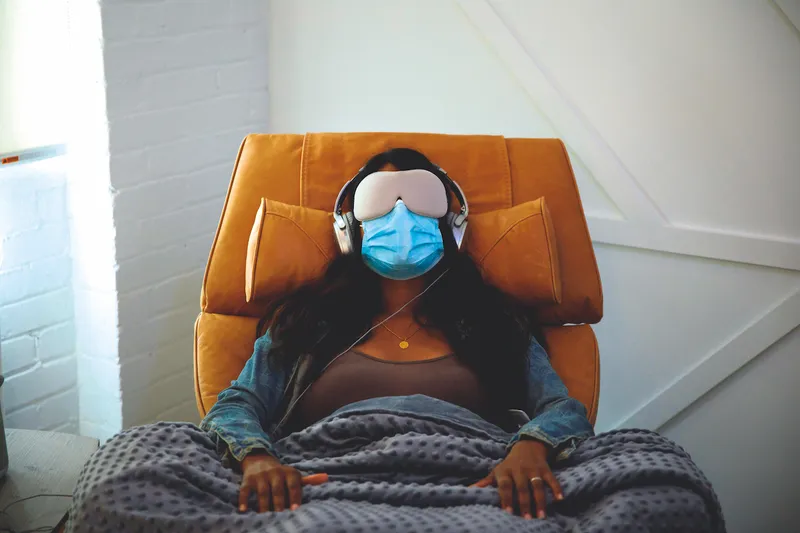How would you go about changing your reality? There are many options available to the modern human, with varying degrees of permanence and legality. But perhaps the simplest method is to find a place where reality is different to what you’re used to, and go there.
I tried this option in November 2022, by attending the Wonderland International Psychedelics conference and exhibition in Miami.
As a Welsh neuroscientist from the Cardiff suburbs, with no involvement with/experience of class-A drugs, exploring an international conference dedicated to them in the heart of a humid US city was, to put it mildly, outside my usual comfort zone.
Psychedelics is a big industry
I was, admittedly, already aware of the ever-increasing evidence for the enormous potential of psychedelics to treat multiple mental health conditions, hence I was keen to attend the event. What I wasn’t aware of, however, was the whole industry that’s built up around them as a result, which has led to many people taking psychedelics in many intriguing (if sometimes baffling) directions.
One that caught my eye at Wonderland was by Enosis Therapeutics, who generously allowed me to experience their AnchoringVR set-up. The brainchild of researcher Agnieszka Sekula, at first glance it appeared to be a virtual reality (VR) simulation of a surprisingly pleasant and realistic moonlit beach environment.
The beach was sprinkled with floating star-like objects, which you could (via the relevant hand controls) pick up and speak into. Anything you said while holding the star would be recorded and saved for retrieval and replay later. Alternatively, you could throw these stars, and their associated audio logs, into the ever-burning campfire present in the scenario.
All very nice and relaxing sounding, but what does it have to do with psychedelics? Or mental health?
In a sense, everything.
Because this is just one example of an interesting and unexpected new approach to treating mental health problems: combining psychedelics and virtual reality.
WARNING
Psychedelics, such as ‘magic mushrooms’ and LSD, are Class A drugs according to UK law. Anyone caught in possession of such substances can face up to seven years in prison, an unlimited fine, or both. Information and support for those affected by substance abuse can be found at bit.ly/drug_support
Humans have been taking psychedelics for 9,000 years
Combining psychedelics and VR may seem like a strange notion, because, in many ways, psychedelics and VR couldn’t be more different.
For one thing, psychedelics are, to put it mildly, ‘old school’. You’d be forgiven for assuming that psychedelics had the biggest impact on our culture during the ‘Psychedelic era’ during the 1960s and 70s. But actually, humankind’s enthusiasm for psychedelics goes back considerably further.

Psychedelics occur naturally in the wild. They can be found in mushrooms, cacti, leaves, stems and more, and for most of our history, humans survived by eating things that grew in the wild. As a consequence, humans have been consuming psychedelics for a very long time.
Tribal rituals involving psychedelics took place as far back as 9,000 years ago. Ergo, humans have been taking psychedelics for literally thousands of years. It’s why they’re so heavily intertwined with rituals and traditions concerning spirituality, mysticism and religion.
None of this applies to VR, however, which is an entirely modern phenomenon. Granted, it has existed in some form since the 1970s, or possibly even the 1950s, but that’s about it.
This is because VR can only exist in the context of modern technology. And as technology has improved, so has interest in VR and its possible applications.
Rather than spirituality and mysticism, VR has historically had more practical applications. NASA has used VR for training purposes for decades, as have various militaries. And it’s constantly threatening to be the next big thing in video gaming.

So, psychedelics and VR have little in common. Unless you count the whole ‘altering the reality we perceive’ aspect. But even here, they go about it in radically different ways.
In a very oversimplified nutshell, psychedelics are biological molecules that interact with certain neuron receptors. This leads to suppression of the brain’s default mode network, the underlying system seemingly crucial for your sense of ‘self’, for internal modes of cognition.
Shutting this network down means your internal processes become mixed up, they overlap, and blur, and your ability to recognise where you are in time and space is compromised.
Virtual reality is 100 per cent controllable
VR, in contrast, leaves the inner workings of your brain well alone. Instead, it blocks out the external sensory environment (to a greater or lesser extent) and substitutes it with a synthetic, technologically generated one.
While a less ‘profound’ experience than that provided by psychedelics, VR offers an alternative reality that’s 100 per cent controllable, and tailor-made to suit the situation.
What if we eventually advance to a point where VR environments are indistinguishable from objective reality? While having none of the restrictions, not even the sky’s the limit for what we could experience with it.
Psychedelics and VR are both means of altering reality but with radically different origins, histories, associations and mechanisms of action.
However, contrary to what most people might assume due to the scaremongering surrounding them, the properties of both psychedelics and VR mean that they have significant scope to have a positive impact on mental health.
Psychedelics make the brain more flexible
It's likely the ‘recreational’ aspects of a ‘trip’ are what most psychedelic enthusiasts are interested in. But scientists are interested in how they make the brain’s internal workings more flexible, malleable and interconnected.
How psychedelics can make it easier to tackle the unhelpful patterns of thought that underlie mental health problems, which are often deeply ingrained into a person's mind.
Psychedelics have a therapeutic potential that’s increasingly hard to ignore. The existence of a three-day conference and exhibition dedicated to them is a stark demonstration of this. As is the recent move by a number of US states (including Oregon and Colorado) to decriminalise the use of psychedelics for therapy research. Likewise, in the case of Australia, to legalise them for prescribed medicinal use.
It’s quite a turnaround when you consider that, barely a decade ago, psychedelics were some of the most restricted drugs around, due to being a casualty of the War on Drugs.
Modern benefits for mental health
Similarly, that modern screen-based technology could be beneficial for mental health may also seem counterintuitive. After all, aren’t we constantly being warned about the damage screen time and smartphone use are doing to our mental wellbeing?
While there is certainly a discussion (preferably an evidence-based one) to be had about such concerns, modern technology has been an increasingly common aspect of mental healthcare for some time now.
Technology that offers bio-feedback or neuro-feedback allows a patient to observe the anomalous things occurring in their body and brain during an anxiety attack. It gives them something more ‘concrete’ to try and get under control.
Digital therapy
We now have digital or online therapies, allowing patients in need to access help remotely via their devices. This relieves pressure and demands on both patients and health services, and such things are now recommended in official guidelines.
There’s also avatar therapy, which creates a helpful and reassuring virtual ‘source’ for a patient’s psychotic audio hallucinations.
All of these things, and many more, are increasingly common means of treating mental health problems, and all are 100 per cent dependent on modern technology.
It’s perhaps unsurprising then, that VR is also becoming an increasingly common therapeutic tool. From allowing 100 per cent controllable and beneficially gradual exposure to the triggers of phobias and post-traumatic stress disorders (PTSD), to rehabilitating dementia patients via more regulated environments.
It now seems that psychedelics and VR do have something in common: they both seem to have great potential as therapeutic tools for mental health. And if they were combined, maybe they’d be even more effective.
Combining the two
As Agnieszka Sekula explained to me at the Wonderland conference, the Enosis AnchoringVR setup is intended for patients who are just completing a psychedelic-assisted therapy session.

This is where a patient takes a dose of psychedelics (usually psilocybin or MDMA) in the presence of a trained therapist. The psychedelic state allows for much greater cognitive flexibility and general positive emotion, increasing the impact of introspection, revelations, insights, and so on. All of which can be very beneficial for mental health conditions and have lasting positive impacts.
But one concern is that the psychedelic state is temporary, and insights and progress acquired during it may not endure beyond it. After all, context is a big part of memory.
A multisensory experience
As Agnieszka explained, “The psychedelic experience is a multisensory, embodied, deeply immersive experience, which is difficult to put into words. Therefore, processing it through the method of talk therapy seems almost counterintuitive – and yet, this is the predominant approach to integration”.
“Immersive (VR) environments allow us to exploit all the senses in therapeutic engagement and give patients an opportunity to express themselves in a multisensory fashion. But also, and perhaps most importantly, they allow them to journey through their expressions, to explore, together with their therapist, the contents of their psyche”
Like video games, you can 'save' your progress
The Enosis AnchoringVR set-up immerses the patient in the previously mentioned beach scenario as they’re recovering from their ‘trip’. Here, they can use the calming multisensory interface to record their insights while they’re still fresh in the patient’s mind, and revisit them, in the same rich context, at the next session, thus better retaining and building on them.
It’s a similar idea to the ‘checkpoints’ you often encounter in video games that let you save your progress, so you don’t have to start all over again each time. This approach essentially provides the same thing for therapy, complete with the advanced graphics!

VR can also be useful at the start of psychedelic therapy. Because it’s such a powerful intervention, psychedelic therapy must be carefully managed. This includes creating the right ‘setting’ to put patients in a suitably positive frame of mind, because psychedelics combined with a negative headspace lead to a ‘bad trip’ – not helpful for someone already dealing with poor mental health.
If the initial environment is important for psychedelic therapy, VR, offering a 100 per cent controllable environment, may well make things much easier for both patient and therapist. There are an increasing number of techniques incorporating VR and psychedelics, or altered consciousness, with increasingly interesting approaches.
What are the downsides?
Some may think this all a bit unlikely. After all, as good as it may be, modern VR is still readily identifiable as artificial. Could it really have such tangible effects on people?
Sure it can. After all, VR motion sickness is definitely a thing, revealing that, while we may consciously recognise VR as artificial, the subconscious processes that do most of the brain’s heavy lifting are perfectly willing to accept it, certainly enough to immediately affect what’s happening in the user’s body.
Of course, it’s still very early days for this intriguing combination of therapeutic interventions. There are still issues to be addressed, such as how psychedelics are very powerful therapeutic tools that need to be used carefully, under professional supervision. Or how effective VR requires much technological support and investment, in terms of both resources and expertise.
Wouldn't they just be better on their own?
There are also those who contend that psychedelic therapy is sufficient in its own right, and including VR in the process is an unnecessary distraction.
Conversely, there are studies which suggest that a therapeutic psychedelic state can be induced via VR alone, removing the need for consumption of potent chemicals. Overall, though, psychedelics and VR represent an interesting, combined-therapy approach and we’re only beginning to explore its potential.
Ultimately, most mental health disorders come about via the things we experience, via the sights, sounds and internal cogitations our brains end up dealing with. If therapists were able to cause the afflicted brains to perceive and experience things that counteracted the things that led to mental health issues, treating them would potentially be a lot easier.
Psychedelics and VR have the potential to offer exactly that. And if we keep combining the two, who knows what we’ll see?
Read more:
- Psychedelic ingredient in magic mushrooms makes music more emotional to our brain
- To death and back: what near-death experiences could tell us about dying
- Psychedelic compound found in magic mushrooms may help with anxiety and depression in cancer patients
To have your mind blown by more science, check out our ultimate fun facts page.
